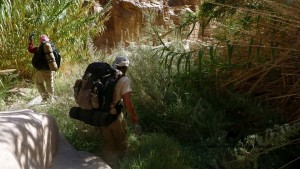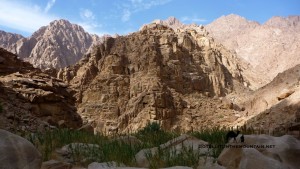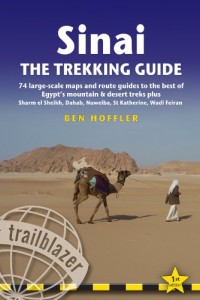December 23, 2014
Wadi Sig: the Sinai jungle
 The Sinai is a desert – every part of it. Most parts get less than 50mm rain a year. Some parts, less than 13mm. It’s a trans-continental sweep of sandy plains and harsh, rocky highlands. Not every part of it though. In some places, the Sinai gets green. It gets overgrown. Walk some wadis and it it feels like you’ve left the desert and entered the jungle. These wadis of the Sinai – the jungle wadis – are absolutely amazing: an environmental oddity you find only on the west side of the peninsula. On the high mountain side. The wetter side, where steep, impervious mountainsides channel all the water direct into the bottom of the wadis. The east side is totally different. The west of the Sinai is where desert meets jungle. There are a few great jungle wadis.
The Sinai is a desert – every part of it. Most parts get less than 50mm rain a year. Some parts, less than 13mm. It’s a trans-continental sweep of sandy plains and harsh, rocky highlands. Not every part of it though. In some places, the Sinai gets green. It gets overgrown. Walk some wadis and it it feels like you’ve left the desert and entered the jungle. These wadis of the Sinai – the jungle wadis – are absolutely amazing: an environmental oddity you find only on the west side of the peninsula. On the high mountain side. The wetter side, where steep, impervious mountainsides channel all the water direct into the bottom of the wadis. The east side is totally different. The west of the Sinai is where desert meets jungle. There are a few great jungle wadis.
And for me, the best of all – the best wadi in the Sinai – is Wadi Sig. I reckon this is the King of the Sinai’s wadis.
It’s the emerald gem; the buried, secret jewel of the peninsula.
There’s hardly any writing about it. I clocked it the first time on a high peak called Jebel el Reeh about a year ago. Far below there was a big wadi that cut down – deep, deep down – as it ran down to the sea.
 It’s overgrown with vegetation for long stretches. And vegetation on a bigger scale than what you find in other wadis. There are giant horsemint bushes higher than your waist and thickets of bamboo where you can’t see where you’re going. Where you have to push your way through. There are places with running water, pools and small waterfalls. And there are huge canyons: long, narrow parts where the sides tower vertically. There’s history too: look carefully on the sides of the wadi and you’ll see little dwellings built into the cliffs. It’s a wadi that has everything. And there’s no let up – it never eases off.
It’s overgrown with vegetation for long stretches. And vegetation on a bigger scale than what you find in other wadis. There are giant horsemint bushes higher than your waist and thickets of bamboo where you can’t see where you’re going. Where you have to push your way through. There are places with running water, pools and small waterfalls. And there are huge canyons: long, narrow parts where the sides tower vertically. There’s history too: look carefully on the sides of the wadi and you’ll see little dwellings built into the cliffs. It’s a wadi that has everything. And there’s no let up – it never eases off.
All these riches aren’t won easily though – Wadi Sig is a tough walk.
And it’s made tougher by the fact it takes you irreversibly deep; it commits you to a remote, multi-day expedition you can’t get out of easily. And one where you have to carry all your stuff except water. Camels can’t come this way. There are no paths. It’s mostly stony river bed terrain. There’s plenty of boulder hopping. Plus bits of scrambling. There are a lot of routefinding puzzles too. We got stuck at one point, jumping down into a black abyss, with a shower of vegetation falling on our heads, before escaping through a bamboo thicket (only to discover a much more sensible way around the other side). Black piping is tied on some rocks so you can abseil in places; but you never go down more than a few metres.
Wadi Sig isn’t technically tricky – it’s just long. And tough. A stamina thing.
 If walking a wadi was a boxing match, Wadi Sig would be the equivalent of going the distance; of doing the full 12 rounds. We did it in a day, starting at 6am, finishing about 5pm, just before sunset; and going fast all the way. Ideally, it’d be better done in two days. The best plan would be to hike in from St Katherine on the first day – which takes about five hours – and then camp in the wadi. Then to continue to the end over the second day. It ends at a junction with Wadi Khareeta. After this, it becomes known as Wadi Mirr. It’s the same wadi – just with a different name – and it runs down to the Plain of Qa.
If walking a wadi was a boxing match, Wadi Sig would be the equivalent of going the distance; of doing the full 12 rounds. We did it in a day, starting at 6am, finishing about 5pm, just before sunset; and going fast all the way. Ideally, it’d be better done in two days. The best plan would be to hike in from St Katherine on the first day – which takes about five hours – and then camp in the wadi. Then to continue to the end over the second day. It ends at a junction with Wadi Khareeta. After this, it becomes known as Wadi Mirr. It’s the same wadi – just with a different name – and it runs down to the Plain of Qa.
The easiest option is to just walk out of Wadi Mirr. It takes about a day to the end of the wadi, where you can find a jeep at a small Bedouin village. The downside of this is the jeep can cost a lot – probably at least LE500 to El Tur considering you won’t have much bargaining power. The other options are 1. to walk out through Wadi Khareeta, which takes you back to St Katherine in 2-3 days 2. to go through Wadi Zeregeiyah, which goes to Jebel Umm Shomer over 1-2 days, after which it’s another day’s walk back to St Katherine. You can also go to a place called Baghabugh, near Jebel Madsus, and then back to St Katherine over 2-3 days. Or you can go over the high pass of Naqb Umm Seikha to Wadi Jibal and back to St Katherine in 2 days. Be warned – none of these routes are easy.
 The easiest of all is the Baghabugh route. This is mostly a hike. All the other routes are off piste adventure routes. Naqb Umm Seikha is the way the postman used to take from El Tur to St Katherine in the 19th century. But it’s seriously steep and would be a monster with a heavy bag. Wadi Khareeta is also steep at the end. Wadi Zeregeiyah is like a mini Wadi Sig, with lots of scrambling; including bits that are more technical than Wadi Sig.
The easiest of all is the Baghabugh route. This is mostly a hike. All the other routes are off piste adventure routes. Naqb Umm Seikha is the way the postman used to take from El Tur to St Katherine in the 19th century. But it’s seriously steep and would be a monster with a heavy bag. Wadi Khareeta is also steep at the end. Wadi Zeregeiyah is like a mini Wadi Sig, with lots of scrambling; including bits that are more technical than Wadi Sig.
And perhaps that’s another great thing about Wadi Sig.
It commits you to a mission where getting out is as much of an adventure as getting in in the first place…
